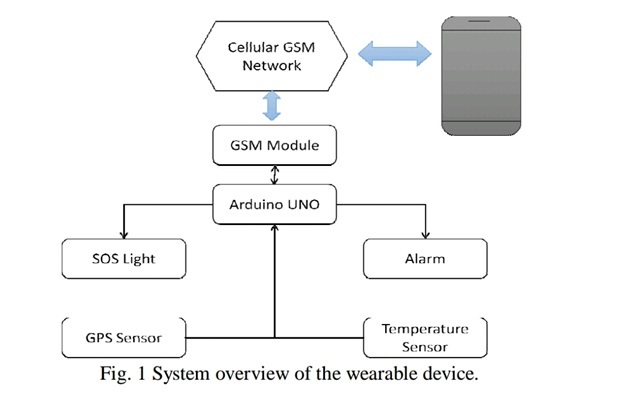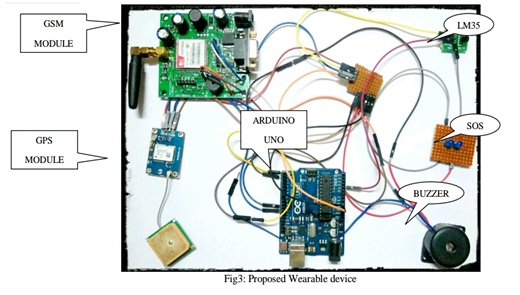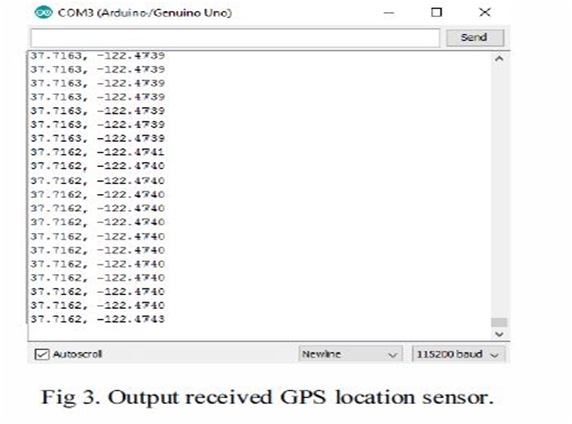





Published on Apr 02, 2024
This paper discusses the concept of a smart wearable device for little children. The major advantage of this wearable over other wearable is that it can be used in any cell phone and doesn't necessarily require an expensive smart phone and not a very tech savvy individual to operate. The purpose of this device is to help parents locate their children with ease.
At the moment there are many wearable in the market which help track the daily activity of children and also help find the child using Wi-Fi and Bluetooth services present on the device. But Wi-Fi and Bluetooth appear to be an unreliable medium of communication between the parent and child. Therefore, the focus of this paper is to have an SMS text enabled communication medium between the child's wearable and the parent as the environment for GSM mobile communication is almost present everywhere.
The parent can send a text with specific keywords such as "LOCATION" "TEMPERATURE" "UV" "SOS" "BUZZ", etc., the wearable device will reply back with a text containing the real time accurate location of the child which upon tapping will provide directions to the child's location on Google maps app and will also provide the surrounding temperature, UV radiation index so that the parents can keep track if the temperature or UV radiation is not suitable for the child.
The prime motivation behind this paper is that we know how important technology is in our lives but it can sometimes can't be trusted, and we always need to have a secondary measure at hand. The secondary measure used in this project is the people present in the surrounding of the child who could instantly react for the child's safety till the parents arrive or they could contact the parents and help locate them.
The secondary measure implemented was using a bright SOS Light and distress alarm buzzer present on the wearable device which when activated by the parents via SMS text should display the SOS signal brightly and sound an alarm which a bystander can easily spot as a sign of distress. Hence this paper aims at providing parents with a sense of security for their child in today's time.
This section discusses the architecture and the design methodologies chosen for the development of the Child Safety wearable device.

An A Tmega328p microcontroller controls the system architecture of the wearable with an Arduino Uno boot- loader. A 5 pin header allows for power (+3 V) and ground connections as well as providing access to TX, RX, and reset pins of the ATMega328p. The Fig illustrates the architecture of the child safety wearable device, which depicts the various technologies and technological standards used. The system architecture of the wearable is based and controlled by an AT - mega328p microcontroller with an Arduino Uno bootloader. The Arduino Uno collects various types of data from the different modules interfaced to it, such as the GPS module upon being triggered by the Arduino GSM shield
The GSM shield is used as an interfaceto send the data received by the Arduino Uno via SMS or MMS to a smart phone over GSM/GPRS. The GSM shield functions as a trigger for the Arduino Uno to request data from its various modules. If an SMS text with distinct characters is sent to request the current location or GPS coordinates is sent to the Arduino GSM shield via the user's smart phone, then the GSM shield triggers the Arduino Uno to request the current GPS coordinates. The GSM shield uses digital pins 2 and 3 for the software serial communication with the MIO.
Pin2 is connected to the MlO's TX pin and pin 3 to its RX pin. The Ml 0 is a Quadband GSM/GPRS modem that works at GSM850Mhz, GSM900Mhz, DCS1800Mhz, and PCS1900Mhz. It also supports TCPI,UDP and HTTP protocols through a GPRS connection. Once the Arduino Uno has received at the coordinate information, it will process this information and transfer it over to the GSM shield, which then via SMS sends the coordinates to the user's smart phone. The user can just tap on the coordinates which will open up the default GPS application installed on the phone and will show the user the distance between the child and the user.
The wearable device, for now, is not built on a SOC model, rather has been proposed using larger components and can later build on the SOC platform once put into manufacture. The wearable IOT device tasked with acquiring various data from the all the different modules connected. It comprises of Arduino Uno based on the ATmega328P microcontroller. It receives the data from its various physically connected modules, anatomizes this data and refines the data in a more user understandable format to the different available user interfaces.

The user, therefore, can conveniently view the information on their cell phone. The physical characteristics of the wearable device are proposed to be as a wrist watch which remains placed around the wrist of the child during times when the child is not being accompanied by an adult/parent. For the moment the design is not made compact, since the main focus now has been to show that this concept of smart wearables would be highly impactful for the safety of children. The wearable system runs on a battery with an output voltage of 5V. In order to maximize power consumption, the wearable device has been programmed to provide GPS and image information only upon request by SMS text via GSM shield.
For determining the real time location of the child Parallax PMB-648 GPS module has been used which communicates with the Arduino Uno through a 4800 bps TTL-level interface. The connections between the Arduino Uno and the GPS module established with three wired connections which enable the Arduino to read the GPS data. The GPS module receives location information from the various satellites present in the NAVSTAR (American Satellites Timing and Ranging Global Positioning System) GPS system. It has a low power conception and size of the only 32x32mm, which is very compact. 20 parallel satellite tracking channels for fast acquisition and reacquisition. The output received from the GPS module is a standard string information which is governed by the National Marine Electronics Association (NMEA) protocol.
To interface the PMB-648 GPS module with the Arduino to provide precise latitude and longitude GPS coordinates, the Tiny GPS library was added into the Arduino IDE. The Yin (red wire) on the PMB-648 GPS module is connected to the 5V pin on the Arduino Uno via jumper cables. Similarly, the GND (black wire) pin on the GPS module is connected to the GND pin on the Arduino Uno via jumper cables. The TXD (yellow wire) is connected to pin 6 of the Arduino Uno via jumper cables on the breadboard. The pin six on the Arduino Uno is a digital pin which can also be used for PWM (Pulse Width Modulation) applications. Once the SMS trigger text "LOCATION" is sent from the cell phone of the user, this text is received by the Arduino GSM Shield which in turn triggers the Arduino Uno to execute the GPS code to fetch the current, accurate location of the GPS module. The location output received from the GPS module is in the following format:

In order to measure the temperature of the surroundings of the child, a seed studio grove temperature sensor was used. The sensor module is equipped with a there mistor for measuring the ambient temperature and the fluctuations with high accuracy. The observable temperature detectability for this sensor ranges from -40°C to -125°C and the precise accuracy for this device range from + 1.5°C to -1.5°C. The temperature
is connected to the Arduino Uno and GSM shield using a Grove base shield which contains eight digital ports ranging from D 1 to D8, four analog ports ranging from AO to A3 and 4 I2C ports. Therefore, the temperature sensor is connected to the A2 analog port of the base shield. The temperature value is stored in a string get Temp(a), where "a" is the integer type. Hence the get Temp(a) is called by the GSM module upon receiving the proper SMS keyword "TEMPERATURE" by the user's smart phone.
The another theory that this paper focusses on is that bystanders are the first mode of help for a missing child. The purpose of the SOS light is to be able to alert the people nearby that the child might be in distress since the light will be flashing the universal SOS light symbol which many people nowadays know for to be a sign for help. This can be activated by the parent itself by sending an SMS text with the keyword "SOS" to the child's wearable which will activate the SOS light flashing. The SOS light works on the principal of Morse code in which "S" stands for three short dots and the "0" stands for three long dashes. Since a very long time, the SOS signal has been universally known for being the sign of distress and help. The SOS signal is referred to by all security personals, who if find the child to be missing can act and help locate the parents with surplus resources present at their disposal. The SOS Light is connected to the pin 13 of the base shield.
In the scenario, if a child is separated from his/her parents. The parent can locate their child by sounding a very loud alarm on the wearable. To achieve this, grove seed studio buzzer was used, which has a piezoelectric module which is responsible for emitting a strong tone upon the output being set to HIGH. The grove buzzer module is activated upon sending an SMS text with the keyword "BUZZ" from a cell phone. Also, this buzzer works similar to the SOS led by alerting the people nearby with the distressed tone that the child might be lost and is in need of assistance. The buzzer is connected to the D4 digital port of the base shield.
It transfers the information over to the user via SMS by using General Packet Radio Service (GPRS) which can provide data rates around 56-114 Kbit/sec. Arduino provides various libraries such as Ethernet, Wi-Fi for the different Arduino shields. Similarly, Arduino provides GSM libraries for their official GSM shield as well which allows the GSM shield to make/receive a call, send/receive SMS and act as a client/server. The Arduino GSM shield receives 5V power supply directly from the 5V pin connection at the Arduino Uno 5V. The serial communication between the Arduino Uno and Arduino GSM shield is performed between the software serial digital pins 2,3 and also reset pins 7. The GSM shield has been programmed to receive SMS text messages from the parent's cell phone.
The GSM shield will constantly be scanning the received text messages for the specific keywords such as "LOCATION" "TEMPERATURE" "UV" "BUZZ" "SOS". If the text message received does not contain any of the pre programed keywords, then the GSM shield had programmed to delete the text message completely and reply back nothing to the sender. Since the GSM shield is an Arduino produced device, it has the necessary GSM libraries installed into the Arduino IDE which makes the interfacing with Arduino Uno much more reliable. The primary reason for using the GSM shield as the mode of communication over Wi-Fi and Bluetooth was that this wearable was aimed at being accessible to any cell phone user and not necessarily an expensive smart phone user. Also, to make the technology as user-friendly as possible, so that a user who is technologically challenged can also use it with ease
An Arduino GSM Shield is used as it transfers the information over to the user via SMS by using General Packet Radio Service (GPRS) which can provide data rates around 56-114 Kbit/sec. Arduino provides various libraries such as Ethernet, Wi-Fi for the different Arduino shields. Similarly, they provide GSM libraries for their official GSM shield as well which allows the GSM shield to make/receive a call, send/receive SMS and act as a client/server.
Gone are the days when buying a GPS enabled Wearable Device for kids was considered a luxury. Today, however, the scenario is different. There are plenty of options readily available. It is easy to buy a smart watch for kids of your choice online. What’s more, these magnificent tech gadgets don’t burn a big hole in your pockets and make up for an affordable buy. Now a smart watch is just a click away! Besides ,these smart-watches lend a style statement to your fashion conscious kids.
Fueled by IOT, the GPS enabled Wearable Device act as a saviour for parents who are always clouded with worries about their kids. Tracking a child was never this easy. These Wearable Device allow parents to track their children in crowded/public places or when they are out of sight say at school, picnic or an outing. Parents can use these smart-watches to track the location of their lost kids.
No matter how tech advanced the smart watches are, they hardly look like one. Most manufacturers have worked hard to mold their tech wonders in a time piece that looks everything but a tech piece! Their childish designs and bright colour combination is perfect to disguise them. This is precisely why most people can hardly spot the difference between a smart watch and an ordinary watch. Good for kids who use them, as their adorable designs keep these watches safe from the prying eyes.
GPS tracker watches are a boon for parents as they help in watching over your kids when either they are away or you are away from them. These devices:
1. Tracks kids when they reach school or arrive home from school.
2. Track kids when they are untraceable in a crowded space.
3. Track kids when they are away from home and out of your sight.
Parents, whether at home or office, are always worried about the safety of their kids. The fear of losing your child to avoidable circumstances is the concern area for all mommies and daddies. On the other hand, a smart watch equipped kid is always traceable and reachable in case of contingencies and emergencies. This in fact, offers great solace for parents, who are relieved at the thought of maintaining an uninterrupted connectivity with their children, anytime, anywhere. Enough to of course, guarantee the much-needed peace of mind
The child safety wearable device is capable of acting as a smart IOT device. It provides parents with the real-time location, surrounding temperature, UV radiation index and SOS light along with Distress alarm buzzer for their child's surroundings and the ability to locate their child or alert bystanders in acting to rescue or comfort the child. The smart child safety wearable can be enhanced much more in the future by using highly compact Arduino modules such as the LilyPadArduino which can be sewed into fabrics. Also a more power efficient model will have to be created which will be capable of holding the battery for a longer time
[1] B. Dorsemaine, 1. P. Gaulier, 1. P. Wary, N. Kheir and P. Urien, "Internet of Things: A Definition and Taxonomy," Next Generation Mobile Applications, Services and Technologies, 2015 9th InternationalConference on, Cambridge, 2015, pp. 72- 77.
[2] H. Moustafa, H. Kenn, K. Sayrafian, W. Scanlon and Y. Zhang, "Mobile wearable communications [Guest Editorial]," in IEEE Wireless Communications, vol. 22, no. 1, pp. lO-l1, February 2015.
[3] S. Nasrin and P. 1. Radcliffe, "Novel protocol enables DIY home automation," Telecommunication Networks and Applications Conference (ATNAC), 2014 Australasian, Southbank, VIC, 2014, pp. 212-216.
[4] F. A. Silva, "Industrial Wireless Sensor Networks: Applications, Protocols, and Standards [Book News]," in IEEE Industrial Electronics Magazine, vol. 8, no. 4, pp. 67-68, Dec.2014.
[5]Jun Zheng; Simplot-Ryl, D.; Bisdikian, c.; Mouftah, H.T., "The internet of things [Guest Editorial]," in Communications Magazine, IEEE , vo1.49, no.ll, pp.30-31, November 2011 doi: 10.1109/MCOM.2011.6069706
| Are you interested in this topic.Then mail to us immediately to get the full report.
email :- contactv2@gmail.com |